
All concrete floors are different and many variables are at play. Some floors are composed of bare concrete. Some of this concrete is old, some new. Some old concrete floors are clean, others are dirty. Some are dirty, others are filthy. Still other floors are painted. Of those, some are holding up beautifully and others are peeling like a summer sunburn.
All too often, folks wander into a Big Box Store on a weekend and just happen to spot a gallon or a kit of “Floor Paint”. They read the can and are informed that after applying two simply coats of this paint to their floor, they’ll have a beautiful, showroom basement.
Some buy into this idea and consequently buy the paint. If you’re curious how their project ends, head to the websites of any of these stores and check out the reviews for their floor paint. Eight times out of ten, the reviews are bad. And almost 100% of those bad reviews are the result of people painting floors in the wrong way, without the right prep. Some are even the results of people painting floors that should NEVER have been painted in the first place.
So, all that to say, before you rush into a paint job on your basement floor, be aware that there’s a level of great deal of information and understanding you need to be able to tackle this project successfully. No, it’s not complicated. Yes, anybody can do it. But it DOES take a few extra steps that you’re not likely to be hear about at your average Big Box Store.
Is painting my floor even an option?
As we mentioned above, some floors are simply not cut out for a paint job. There are certain situations that simply preclude the option of painting.
If you’re wondering about your floor, work your way through the following steps for the following scenarios:
1. YOUR FLOOR IS BARE CONCRETE (Old or New)
A. IS IT CURED? The starting point with bare concrete is to determine whether or not the floor has cured for at least 60 days. If it hasn’t, wait until it has. If it has cured for anywhere from 60 days to 50 (or more) years, proceed to “B” below.
B. TEST FOR MOISTURE: Duct Tape a 2 x 2 sheet of plastic to your floor, secure the edges of the tape to ensure a tight bond, and let it sit for 24 hours. After the 24 hour time frame, pull up the plastic and examine it: is there condensation visible? Has the concrete in that spot darkened? If so, you still have moisture in the concrete and should let it continue to dry. If your concrete is old and still exhibits a moisture problem as evidenced by the plastic test, you should reconsider painting that floor. It has a moisture issue and will definitely result in paint failure. In short, if your floor is old and still exhibits a moisture problem, it’s NOT a candidate for a paint job.
2. YOUR FLOOR HAS PREVIOUSLY BEEN PAINTED
A. IS THE PAINT PEELING? Examine your painted floor: is it peeling or flaking off in relatively large quantities? Some peeling or chipping can be expected, but if you’re seeing large scale failure, that is an indication of a deeper problem. The problem could be a surface contaminant that was painted over or, more likely it’s a moisture problem in your concrete.
1. IS IT A SURFACE CONTAMINANT PROBLEM? If the peeling is relatively localized–a few large areas–it COULD be a surface contaminant. One option would be to clean those spots with a household detergent, let them dry and then proceed to painting (we’ll discuss this in a later post). However, be aware, that this is no guarantee. The peeling paint could be caused by a surface contaminant, but it could also be caused by moisture (see below). And, even if it is a surface contaminant, it’s very likely that it’s in more places than just the spots you see now. You could clean up and fix those spots only to find, within a few months, other spots starting to let loose and peel. This is frustrating and is one of those perfect examples of why the proper prep work is so important! If the first steps are done incorrectly–especially on a floor–ALL subsequent work is affected!
2. IS THERE A MOISTURE PROBLEM? While the peeling you see could be a cause of a surface contaminant, it’s much more likely it’s a moisture problem. Moisture can work through concrete in any number of ways, but the important thing to realize is this: if you’ve got excess moisture coming through your concrete, for whatever reason (unless the floor wasn’t allowed to cure 60 days), it’s virtually impossible to fix. Painting over the cement will temporarily make it look good, but the moisture will eventually (sometimes sooner, sometimes later) push that paint coating off.
3. CONCLUSION: If your painted floor exhibits peeling on a large scale, it’s likely not a good candidate for a paint job. However, since it’s painted, you will likely want to at least throw a new coat on there. Go ahead and scrape off as much loose paint as you can, wash the floor and rinse it well (we’ll discuss this step in a later post). Then you’ll be ready to paint. Just understand that your previous paint didn’t bond for a reason and it’s very likely the new paint will eventually peel as well.
B. THE PAINT IS NOT PEELING AND IS IN GOOD CONDITION: If your previous coating is holding up well, all you’ll need to do is give it a quick wash, a good rinse, and some time to dry. Then it’s time to paint.
As I’ve mentioned multiple times in this post, we’ll dig into the washing, rinsing and drying steps in a later post. This first one was meant to help you determine whether or not your floor was even a candidate for a paint job. If it’s not, think about carpet or tile or maybe just leaving it alone. If it is, look for the next part of the discussion tomorrow.



 Very often when folks are at the lumber yard picking out wood for a particular home project, they choose Poplar. The reason is because it looks beautiful in its unstained, natural form and it’s very easy to work with. It also can be less expensive than woods like Cherry. And so, many homeowners pick up Poplar and then go to work trimming out their kitchen or living room or building a bookcase or two.
Very often when folks are at the lumber yard picking out wood for a particular home project, they choose Poplar. The reason is because it looks beautiful in its unstained, natural form and it’s very easy to work with. It also can be less expensive than woods like Cherry. And so, many homeowners pick up Poplar and then go to work trimming out their kitchen or living room or building a bookcase or two.
 “My name’s Dan and I’m a recovering Prep Work Skipper.”
“My name’s Dan and I’m a recovering Prep Work Skipper.” Has this ever happened to you: you walk into the paint store for paint and then spend the next three days or a week or more agonizing over the color chips you brought home? You hold them up to every piece of furniture in the room. You lay them on your carpet, on your end table. You try to picture them large scale–covering your walls. You debate between one shade and a slightly darker shade. And then, finally, after all the debate and analysis and agony, you pick the perfect colors.
Has this ever happened to you: you walk into the paint store for paint and then spend the next three days or a week or more agonizing over the color chips you brought home? You hold them up to every piece of furniture in the room. You lay them on your carpet, on your end table. You try to picture them large scale–covering your walls. You debate between one shade and a slightly darker shade. And then, finally, after all the debate and analysis and agony, you pick the perfect colors. Most folks forget about their ceilings when it comes time to paint and as a result, most ceilings are forgettable.
Most folks forget about their ceilings when it comes time to paint and as a result, most ceilings are forgettable. However, there’s something very interesting to realize here: many folks understand this concept and they figure that painting those ceilings white will really serve to open the room up. However, think about this: if you’ve got a medium toned color on your walls, no matter what shade, a white on the ceiling can often produce a very sharp distinction between the walls and the ceiling. This sharp distinction, this high contrast between walls and ceiling, can often lead people to conclude that their wall color doesn’t work–that it needs to be repainted.
However, there’s something very interesting to realize here: many folks understand this concept and they figure that painting those ceilings white will really serve to open the room up. However, think about this: if you’ve got a medium toned color on your walls, no matter what shade, a white on the ceiling can often produce a very sharp distinction between the walls and the ceiling. This sharp distinction, this high contrast between walls and ceiling, can often lead people to conclude that their wall color doesn’t work–that it needs to be repainted. Imagine the same room with a white ceiling. In fact, you don’t have to imagine it, look at the picture below. That’s the same room with a standard white on the ceiling and the whole mood of the room changes. The stark white on the ceiling makes the green on the walls feel harsh. Many times, folks would paint a room like this, think they love that green, only to be back later for new paint because the color’s just too strong on the walls.
Imagine the same room with a white ceiling. In fact, you don’t have to imagine it, look at the picture below. That’s the same room with a standard white on the ceiling and the whole mood of the room changes. The stark white on the ceiling makes the green on the walls feel harsh. Many times, folks would paint a room like this, think they love that green, only to be back later for new paint because the color’s just too strong on the walls.
 I’m cheap. I’ve probably written that before, but that doesn’t matter. I’m so cheap, it’s legitimate to write it again. But that cheapness has it’s limits.
I’m cheap. I’ve probably written that before, but that doesn’t matter. I’m so cheap, it’s legitimate to write it again. But that cheapness has it’s limits.
 Every now and again, a new product enters the home decorating field and changes the way everything is done. Today I want to very briefly highlight one such product: 3M’s Delicate Surface Masking Tape.
Every now and again, a new product enters the home decorating field and changes the way everything is done. Today I want to very briefly highlight one such product: 3M’s Delicate Surface Masking Tape.